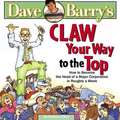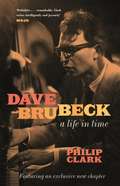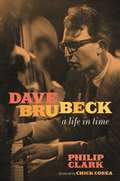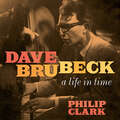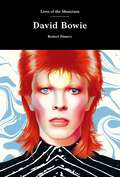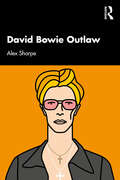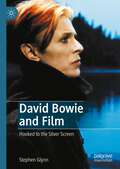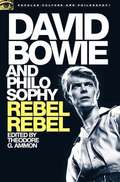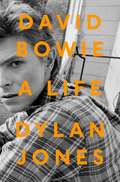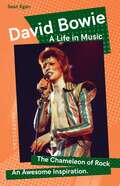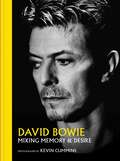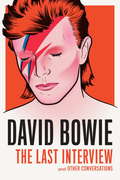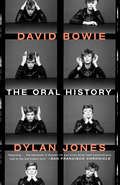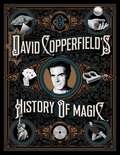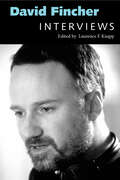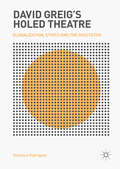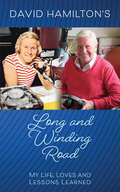- Table View
- List View
Dave Barry's Book of Bad Songs
by Dave BarryThe humorist asked his readers to share their least favorite tunes and chronicles the hilarious responses.When funnyman Dave Barry asked readers about their least favorite tunes, he thought he was penning just another installment of his weekly syndicated humor column. But the witty writer was flabbergasted by the response when over 10,000 readers voted. “I have never written a column that got a bigger response than the one announcing the Bad Song Survey,” Barry wrote.Based on the results of the survey, Dave Barry’s Book of Bad Songs is a compilation of some of the worst songs ever written. Dave Barry fans will relish his quirky take. Music buffs too will appreciate this humorous stroll through the world’s worst lyrics. The only thing wrong with this book is that readers will find themselves unable to stop mentally singing the greatest hits of Gary Puckett.Praise for Dave Barry’s Book of Bad Songs“Barry is his usual puckish self, but the real surprise here is how funny many of the survey respondents are.” —Kirkus Reviews“Who can resist such a book?” —Publishers Weekly
Dave Barry's Claw Your Way To The Top: How To Become The Head Of A Major Corporation In Roughly A Week
by Dave Barry Jerry O'BrienWorking up the corporate ladder is all well and good for most people, but you are not "most people." You are a highly motivated individual who wants to be on the fast track, and you cannot afford to fritter away valuable time working diligently and competently on the job. You need Dave Barry's surefire tips in Claw Your Way to the Top!<P> * "A good resume is more than just a piece of paper. It can mean the difference between not getting a job and not even coming close."<P> * "Can you get a job in business? Heck yes! Don't you listen to those Negative Nellies who tell you there aren't any good jobs anymore, just because the steel, automobile, shoe, clothing, railroad, and agricultural industries have all collapsed!"<P> * "I don't mean to suggest for a moment that all it takes to be a top executive is a custom-tailored European suit. You also need the correct shirt and tie."<P> * "Remember, your subordinates are not machines. They are human beings with the same dreams as you. OK, maybe not all the same dreams. Probably they don't have the one where you're naked in a vat of Yoo-Hoo with the Soviet gymnastics team."<P> * "Ask any business school professor, and he'll tell you a good memo is clear, concise, and well-organized. Now ask him what his annual salary is. It's probably less than most top executives spend in a month on shoe maintenance."
Dave Barry's Money Secrets: Like: Why Is There a Giant Eyeball on the Dollar?
by Dave BarryDid you ever wish that you really understood money? Well, Dave Barry wishes that he did, too. But that hasn't stopped him from writing this book. In it, Dave explores (as only he can) such topics as: * How the U. S. economy works, including the often overlooked role of Adam Sandler * Why it is not a good idea to use squirrels for money * Strategies that will give you the confidence you need to try for a good job, even though you are--let's be honest--a no-talent loser * How corporate executives, simply by walking into their offices, immediately become much stupider * An absolutely foolproof system for making money in the stock market, requiring only a little effort (and access to time travel) * Surefire tips for buying and selling real estate, the key being: Never buy--or, for that matter, sell--real estate * How to minimize your federal taxes, safely and legally, by cheating * Why good colleges cost so much, and how to make sure your child does not get into one * How to reduce the cost of your medical care by basically not getting any * Estate planning, especially the financial benefits of an early death * And many, many pictures of Suze Orman But that's only the beginning! Dave has also included in this book all of the important points from a book written by Donald Trump, so you don't have to read it yourself. Plus he explains how to tip, how to negotiate for everything (including bridge tolls), how to argue with your spouse about money, and how much allowance to give your children (three dollars is plenty). He also presents, for the first time in print anywhere, the Car Dealership Code of Ethics ("Ethic Seven: The customer is an idiot"). Also, there are many gratuitous references to Angelina Jolie naked. You can't afford not to buy this book! Probably you need several copies. What kind of financial shape are you in right now? This scientific quiz will show you. Be honest in your answers: If you lie, you'll only be lying to yourself! The place to lie is on your federal tax return. What is your annual income? 1. More than $50,000. 2. Less than $50,000. 3. However much I get when I return these empties. Not counting your mortgage, how much money do you currently owe? 1. Less than $10,000. 2. More than $10,000. 3. Men are threatening to cut off my thumbs. How would you describe your portfolio? 1. Conservative, mainly bonds and blue-chip equities. 2. Aggressive, mainly options and speculative stocks. 3. My what? When analyzing an investment, what do you consider to be the most important factor? 1. The amount of return. 2. The degree of risk. 3. The name of the jockey. How do you plan to finance your retirement? 1. Savings. 2. Social security. 3. Sale of kidneys. --from the Introduction: "Why You Need This Book".
Dave Brubeck: A Life In Time
by Philip ClarkWINNER OF THE PRESTO JAZZ BOOK OF THE YEAR 2020An articulate, scrupulously researched account based on first-hand information, this book presents Brubeck's contribution to music with the critical insight that it deserves - ***** BBC Music Magazine This is the writing about jazz that we've been waiting for - Mike WestbrookThe sheer descriptive verve, page after page, made me want to listen to every single musical example cited. A major achievement - Stephen Hough'Definitive . . . remarkable. Clark writes intelligently and joyously.' - MojoIn 2003, music journalist Philip Clark was granted unparalleled access to jazz legend Dave Brubeck. Over the course of ten days, he shadowed the Dave Brubeck Quartet during their extended British tour, recording an epic interview with the bandleader. Brubeck opened up as never before, disclosing his unique approach to jazz; the heady days of his 'classic' quartet in the 1950s-60s; hanging out with Duke Ellington, Charlie Parker, Louis Armstrong, and Miles Davis; and the many controversies that had dogged his 66-year-long career.Alongside beloved figures like Ella Fitzgerald and Frank Sinatra, Brubeck's music has achieved name recognition beyond jazz. But finding a convincing fit for Brubeck's legacy, one that reconciles his mass popularity with his advanced musical technique, has proved largely elusive. In Dave Brubeck: A Life in Time, Clark provides us with a thoughtful, thorough, and long-overdue biography of an extraordinary man whose influence continues to inform and inspire musicians today.Structured around Clark's extended interview and intensive new research, this book tells one of the last untold stories of jazz, unearthing the secret history of 'Take Five' and many hitherto unknown aspects of Brubeck's early career - and about his creative relationship with his star saxophonist Paul Desmond. Woven throughout are cameo appearances from a host of unlikely figures from Sting, Ray Manzarek of The Doors, and Keith Emerson, to John Cage, Leonard Bernstein, Harry Partch, and Edgard Varèse. Each chapter explores a different theme or aspect of Brubeck's life and music, illuminating the core of his artistry and genius.
Dave Brubeck: A Life in Time
by Philip ClarkThe definitive, investigative biography of jazz legend Dave Brubeck ("Take Five")In 2003, music journalist Philip Clark was granted unparalleled access to jazz legend Dave Brubeck. Over the course of ten days, he shadowed the Dave Brubeck Quartet during their extended British tour, recording an epic interview with the bandleader. Brubeck opened up as never before, disclosing his unique approach to jazz; the heady days of his "classic" quartet in the 1950s-60s; hanging out with Duke Ellington, Charlie Parker, Louis Armstrong, and Miles Davis; and the many controversies that had dogged his 66-year-long career. Alongside beloved figures like Ella Fitzgerald and Frank Sinatra, Brubeck's music has achieved name recognition beyond jazz. But finding a convincing fit for Brubeck's legacy, one that reconciles his mass popularity with his advanced musical technique, has proved largely elusive. In Dave Brubeck: A Life in Time, Clark provides us with a thoughtful, thorough, and long-overdue biography of an extraordinary man whose influence continues to inform and inspire musicians today. Structured around Clark's extended interview and intensive new research, this book tells one of the last untold stories of jazz, unearthing the secret history of "Take Five" and many hitherto unknown aspects of Brubeck's early career - and about his creative relationship with his star saxophonist Paul Desmond. Woven throughout are cameo appearances from a host of unlikely figures from Sting, Ray Manzarek of The Doors, and Keith Emerson, to John Cage, Leonard Bernstein, Harry Partch, and Edgard Varèse. Each chapter explores a different theme or aspect of Brubeck's life and music, illuminating the core of his artistry and genius. To quote President Obama, as he awarded the musician with a Kennedy Center Honor: "You can't understand America without understanding jazz, and you can't understand jazz without understanding Dave Brubeck."
Dave Brubeck: A Life in Time
by Philip ClarkThe definitive, investigative biography of jazz legend Dave Brubeck.In 2003, music journalist Philip Clark was granted unparalleled access to jazz legend Dave Brubeck. Over the course of ten days, he shadowed the Dave Brubeck Quartet during their extended British tour, recording an epic interview with the bandleader. Brubeck opened up as never before, disclosing his unique approach to jazz; the heady days of his 'classic' quartet in the 1950s-60s; hanging out with Duke Ellington, Charlie Parker, Louis Armstrong, and Miles Davis; and the many controversies that had dogged his 66-year-long career.Alongside beloved figures like Ella Fitzgerald and Frank Sinatra, Brubeck's music has achieved name recognition beyond jazz. But finding a convincing fit for Brubeck's legacy, one that reconciles his mass popularity with his advanced musical technique, has proved largely elusive. In Dave Brubeck: A Life in Time, Clark provides us with a thoughtful, thorough, and long-overdue biography of an extraordinary man whose influence continues to inform and inspire musicians today.Structured around Clark's extended interview and intensive new research, this book tells one of the last untold stories of jazz, unearthing the secret history of 'Take Five' and many hitherto unknown aspects of Brubeck's early career - and about his creative relationship with his star saxophonist Paul Desmond. Woven throughout are cameo appearances from a host of unlikely figures from Sting, Ray Manzarek of The Doors, and Keith Emerson, to John Cage, Leonard Bernstein, Harry Partch, and Edgard Varèse. Each chapter explores a different theme or aspect of Brubeck's life and music, illuminating the core of his artistry and genius.(P) 2020 Hachette Audio
Dave Hill Doesn't Live Here Anymore
by Dave HillWith his signature matter-of-fact humor, comedian and musician Dave Hill explores his increasingly close relationship with his recently widowed father in a series of painfully funny essays you will want to read again and again by the fire, at the beach, in a truck stop men's room, or just about anywhere. It's your call, really.These days, Dave has just the right amount of spare time to write books at home, preferably in his underwear, but things weren't always perfect. When he found himself pushing thirty while still living with his parents in Cleveland, unsuited for anything but what an "employment expert" vaguely called a career in "art, music, writing, or entertainment," he decided to visit some friends in New York for the weekend and never left. However, getting his life together wasn't as easy as he'd hoped, and even an illegally subletted, rent controlled fifth-floor walk-up studio apartment with a (for the most part) working toilet wasn't glamorous enough to erase the fact that his four siblings were all married with steady jobs and actual human offspring. And in recent years, Dave's father had grown tired of loaning him cash and living alone in the empty family home, neither of which made much sense to Dave, but whatever.Through the process of his father's eventual move to a retirement community, Dave and his dad bonded over the things in life that really matter: scorching-hot rock jams, the gluten allergy craze, eighteen-wheelers, Italian food (pizza and spaghetti), and whatever else could possibly be left after that. Meanwhile, Dave discovered his late-blooming manhood via experiences as disparate and dangerous as a visit to a remote Mexican prison, where he learned that people everywhere love the Eagles, and a martial arts class that pushed his resolve and his groin to their limit. In Dave Hill Doesn't Live Here Anymore, Hill's voice is sharp, carefree, laced with just the right amount of profanity, and he is--seemingly despite himself--deeply empathetic as he portrays a difficult time in his family's life and grows up just enough to realize that maybe he and his dad aren't so different after all.
David Bowie (Lives of the Musicians)
by Robert DimeryA relentless innovator, scoring chart hits while simultaneously incorporating radical and ground-breaking elements into his work.As with all great pop stars, Bowie's image changed with almost every new album release. This appetite for reinvention, both musically and visually, saw him dubbed the 'chameleon of pop'. But Bowie's influence extended well beyond his discography and make-up drawer. His androgynous qualities and public statements on his sexuality proved liberating for those who were uncertain about their own. Lives of the Musicians: David Bowie covers the years he spent struggling to find the right artistic outlet to the dramatic breakthrough in 1972 with Ziggy Stardust - and afterwards, the excessive lifestyle that nearly cost him his sanity. It continues with his artistic rebirth in Berlin during the late Seventies, the mainstream success he achieved with Let's Dance in 1983 and the artistic price that he paid for it.
David Bowie (Lives of the Musicians)
by Robert DimeryA relentless innovator, scoring chart hits while simultaneously incorporating radical and ground-breaking elements into his work.As with all great pop stars, Bowie's image changed with almost every new album release. This appetite for reinvention, both musically and visually, saw him dubbed the 'chameleon of pop'. But Bowie's influence extended well beyond his discography and make-up drawer. His androgynous qualities and public statements on his sexuality proved liberating for those who were uncertain about their own. Lives of the Musicians: David Bowie covers the years he spent struggling to find the right artistic outlet to the dramatic breakthrough in 1972 with Ziggy Stardust - and afterwards, the excessive lifestyle that nearly cost him his sanity. It continues with his artistic rebirth in Berlin during the late Seventies, the mainstream success he achieved with Let's Dance in 1983 and the artistic price that he paid for it.
David Bowie Outlaw: Essays on Difference, Authenticity, Ethics, Art & Love
by Alex SharpeThis book explores the relevance of David Bowie’s life and music for contemporary legal and cultural theory. Focusing on the artist and artworks of David Bowie, this book brings to life, in essay form, particular theoretical ideas, creative methodologies and ethical debates that have contemporary relevance within the fields of law, social theory, ethics and art. What unites the essays presented here is that they all point to a beyond law: to the fact that law is not enough, or to be more precise, too much, too much to bear. For those who, like Bowie, see art, creativity and love as what ought to be the central organising principles of life, law will not do. In the face of its certainties, its rigidities, and its conceits, these essays, through Bowie, call forth the monster who laughs at the law, celebrate inauthenticity as a deeper truth, explore the ethical limits of art, cut up the laws of writing and embrace that which is most antithetical to law, love. This original engagement with the limits of law will appeal to those working in legal theory, ethics and law and popular culture, as well as in art and cultural studies.
David Bowie and Film: Hooked to the Silver Screen
by Stephen GlynnThis book constitutes the first monograph dedicated to an academic analysis of David Bowie’s appearances in film. Through close textual analysis together with production and reception histories, Bowie’s ‘silver screen’ career is explored in full. The book covers performance documentaries such as Ziggy Stardust and the Spiders from Mars, star vehicles ranging from the eulogised The Man Who Fell to Earth to the excoriated Just a Gigolo, plus roles from the horror chic of The Hunger and cult fantasy of Labyrinth to the valiant high-brow Baal and vainglorious high-budget Absolute Beginners, ending with Bowie as Bowie in Bandslam and others as ‘Bowie’ in Velvet Goldmine and Stardust. Alongside showing his willingness to experiment (and at times fail) across a variety of genres, this study investigates Bowie’s performative style that, while struggling to accommodate the requirements of cinematic realism, fits more harmoniously with alternative production codes and aesthetics. More broadly, by exploring the commercial, socio-cultural and ideological significance of Bowie on film, the book demonstrates how notions of gender, sexuality and identity formation, plus commodity and cultural capital, function and fluctuate in contemporary society.
David Bowie and Philosophy: Rebel, Rebel
by Theodore G. AmmonAmong the topics explored in David Bowie and Philosophy are the nature of Bowie as an institution; Bowie's work in many platforms, including movies and TV; Bowie's spanning of low and high art, and his relation to Warhol; the influence of Buddhism and Kabuki theater; the recurring theme of Bowie as a space alien, including "Space Oddity" and The Man Who Fell to Earth; the dystopian element in Bowie's thinking, displayed in "1984" and the album Outside; the role of fashion in Bowie's creativity; personal identity as preserved over various divergent personae; the aesthetics of theatrical rock and glam rock; Bowie's public identification with bisexuality and his influence within the LGBTQ community.Pervasive themes in Bowie's output include change, time, apocalypse, dancing, mind-body dualism, and spirituality. In the dualistic universe that undergirds his lyrics, body consistently wins over mind, but body is nevertheless on the hook of moral responsibility. There is thus an inherent tension: the overwhelming desires of bodily drives versus the repressive institutions such as church and the omnipresent "They" who would have us do otherwise than our body want. The emergent paradox in Bowie is that for all his alleged sexual indulgences, in the end mind trumps body.
David Bowie and Romanticism (Palgrave Studies in Music and Literature)
by James RoviraDavid Bowie and Romanticism evaluates Bowie’s music, film, drama, and personae alongside eighteenth- and nineteenth-century poets, novelists, and artists. These chapters expand our understanding of both the literature studied as well as Bowie’s music, exploring the boundaries of reason and imagination, and of identity, gender, and genre. This collection uses the conceptual apparata and historical insights provided by the study of Romanticism to provide insight into identity formation, drawing from Romantic theories of self to understand Bowie’s oeuvre and periods of his career. The chapters discuss key themes in Bowie’s work and analyze what Bowie has to teach us about Romantic art and literature as well.
David Bowie: A Life
by Dylan JonesDylan Jones's engrossing, magisterial biography of David Bowie is unlike any Bowie story ever written. Drawn from over 180 interviews with friends, rivals, lovers and collaborators, some of whom have never before spoken about their relationship with Bowie, this oral history weaves a hypnotic spell as it unfolds the story of a remarkable rise to stardom and an unparalleled artistic path. Tracing Bowie's life from the English suburbs to London to New York to Los Angeles, Berlin and beyond, its collective voices describe a man profoundly shaped by his relationship with his schizophrenic half-brother Terry; an intuitive artist who could absorb influences through intense relationships and yet drop people cold when they were no longer of use; and a social creature equally comfortable partying with John Lennon and dining with Frank Sinatra. By turns insightful and deliciously gossipy, David Bowie is as intimate a portrait as may ever be drawn. It sparks with admiration and grievances, lust and envy, as the speakers bring you into studios and bedrooms they shared with Bowie, and onto stages and film sets, opening corners of his mind and experience that transform our understanding of both artist and art. Including illuminating, never-before-seen material from Bowie himself, drawn from a series of Jones's interviews with him across two decades, David Bowie is an epic, unforgettable cocktail-party conversation about a man whose enigmatic shapeshifting and irrepressible creativity produced one of the most sprawling, fascinating lives of our time.
David Bowie: A Life in Music (Want to know More about Rock & Pop?)
by Sean EganFor the Internet generation, a quick introduction to the great and inventive chameleon of rock, David Bowie.David Bowie needs no introduction. An immense star whose music and writing transcended generations he was one of the most articulate influencers of modern music. Over fifty years his singles and albums slid up and down the bestseller charts, adapting to the changing times, exploring new musical themes, always pushing at boundaries in a desperate desire to seek out the new and the different. This fantastic new, unofficial biography covers his life, music, art and movies.
David Bowie: Mixing Memory & Desire
by Kevin CumminsDavid Bowie: Mixing Memory & Desire includes some of the best images of Bowie ever taken, the majority of which have never been published until now. A then 19-year old photography student from Manchester, Kevin Cummins, who photographed Bowie as Ziggy Stardust in 1973, caught the singer's attention with his impressive images that soon became iconic. Bowie allowed him personal access and they made history together, spanning four decades. The photographs capture the amazing metamorphosis of Bowie through his various personas such as Ziggy Stardust, Aladdin Sane, and The Thin White Duke. This collection illuminates the singer's brilliance, creativity, and personality, capturing him in rare and intimate moments. David Bowie: Mixing Memory & Desire is a remarkable opportunity to see Bowie's contribution to music, fashion, and culture, making it a keepsake for fans everywhere. Kevin Cummins went on to photograph some of the best acts in the U.K. music scene and has had photos displayed in museums, on many album covers, and on book jackets. AN INTIMATE LOOK AT DAVID BOWIE: A special photographic journey capturing the iconic singer on stage, outside, and in more quiet, personal moments. 200 PHOTOS, SOME NEVER BEFORE SEEN: Kevin Cummins' incomparable collection of images shows Bowie and his alter egos in exciting ways. PERFECT GIFT FOR MUSIC FANS: Just in time for the holidays, a great gift for the music lover and a wonderful package to behold. BEHIND THE SCENES STORIES: Photographer Kevin Cummins shares moments from his time with Bowie, including the photo of Bowie that launched Kevin's career at just 19 years old.
David Bowie: The Last Interview
by David BowieThe massive, world-wide outpouring of grief at the death of David Bowie notably focused on not only his stunning musical output, but also his fascinating refusal to stay the same--the same as other trending artists, or even the same as himself. In this remarkable collection, Bowie reveals the fierce intellectualism, artistry, and humor behind it all. From his very first interview--as a teenager on the BBC, before he was even a musician--to his last, Bowie takes on the most probing questions, candidly discussing his sexuality, his drug usage, his sense of fashion, how he composed, and more. For fans still mourning his passing, as well as for those who know little about him, it's a revealing, interesting, and inspiring look at one of the most influential artists of the last fifty years.
David Bowie: The Oral History
by Dylan JonesDylan Jones’s engrossing, magisterial biography of David Bowie is unlike any Bowie story ever written. Drawn from over 180 interviews with friends, rivals, lovers, and collaborators, some of whom have never before spoken about their relationship with Bowie, this oral history weaves a hypnotic spell as it unfolds the story of a remarkable rise to stardom and an unparalleled artistic path. Tracing Bowie’s life from the English suburbs to London to New York to Los Angeles, Berlin, and beyond, its collective voices describe a man profoundly shaped by his relationship with his schizophrenic half-brother Terry; an intuitive artist who could absorb influences through intense relationships and yet drop people cold when they were no longer of use; and a social creature equally comfortable partying with John Lennon and dining with Frank Sinatra. By turns insightful and deliciously gossipy, DAVID BOWIE is as intimate a portrait as may ever be drawn. It sparks with admiration and grievances, lust and envy, as the speakers bring you into studios and bedrooms they shared with Bowie, and onto stages and film sets, opening corners of his mind and experience that transform our understanding of both artist and art. Including illuminating, never-before-seen material from Bowie himself, drawn from a series of Jones’s interviews with him across two decades, DAVID BOWIE is an epic, unforgettable cocktail-party conversation about a man whose enigmatic shapeshifting and irrepressible creativity produced one of the most sprawling, fascinating lives of our time.
David Copperfield's History of Magic
by Richard Wiseman David Copperfield David BritlandAn illustrated, illuminating insight into the world of illusion from the world&’s greatest and most successful magician, capturing its audacious and inventive practitioners, and showcasing the art form&’s most famous artifacts housed at David Copperfield&’s secret museum.In this personal journey through a unique and remarkable performing art, David Copperfield profiles twenty-eight of the world&’s most groundbreaking magicians. From the 16th-century magistrate who wrote the first book on conjuring to the roaring twenties and the man who fooled Houdini, to the woman who levitated, vanished, and caught bullets in her teeth, David Copperfield&’s History of Magic takes you on a wild journey through the remarkable feats of the greatest magicians in history. These magicians were all outsiders in their own way, many of them determined to use magic to escape the strictures of class and convention. But they all transformed popular culture, adapted to social change, discovered the inner workings of the human mind, embraced the latest technological and scientific discoveries, and took the art of magic to unprecedented heights. The incredible stories are complimented by over 100 never-before-seen photographs of artifacts from Copperfield&’s exclusive Museum of Magic, including a 16th-century manual on sleight of hand, Houdini&’s straightjackets, handcuffs, and water torture chamber, Dante&’s famous sawing-in-half apparatus, Alexander&’s high-tech turban that allowed him to read people&’s minds, and even some coins that may have magically passed through the hands of Abraham Lincoln. By the end of the book, you&’ll be sure to share Copperfield&’s passion for the power of magic.
David Cronenberg: Interviews (Conversations with Filmmakers Series)
by David SchwartzFrom his early horror movies, including Scanners, Videodrome, Rabid, and The Fly—with their exploding heads, mutating sex organs, rampaging parasites, and scientists turning into insects—to his inventive adaptations of books by William Burroughs (Naked Lunch), Don DeLillo (Cosmopolis), and Bruce Wagner (Maps to the Stars), Canadian director David Cronenberg (b. 1943) has consistently dramatized the struggle between the aspirations of the mind and the messy realities of the flesh. “I think of human beings as a strange mixture of the physical and the non-physical, and both of these things have their say at every moment we’re alive,” says Cronenberg. “My films are some kind of strange metaphysical passion play.” Moving deftly between genre and arthouse filmmaking and between original screenplays and literary adaptations, Cronenberg’s work is thematically consistent and marked by a rigorous intelligence, a keen sense of humor, and a fearless engagement with the nature of human existence. He has been exploring the most primal themes since the beginning of his career and continues to probe them with growing maturity and depth.Cronenberg’s work has drawn the interest of some of the most intelligent contemporary film critics, and the fifteen interviews in this volume feature remarkably in-depth and insightful conversations with such acclaimed writers as Amy Taubin, Gary Indiana, David Breskin, Dennis Lim, Richard Porton, Gavin Smith, and more. The pieces herein reveal Cronenberg to be one of the most articulate and deeply philosophical directors now working, and they comprise an essential companion to an endlessly provocative and thoughtful body of work.
David Fincher: Interviews (Conversations with Filmmakers Series)
by Laurence F. KnappDavid Fincher (b. 1962) did not go to film school and hates being defined as an auteur. He prefers to see himself as a craftsman, dutifully going about the art and business of making film. Trouble is, it's hard to be self-effacing when you are the director responsible for Se7en, Fight Club, and The Social Network. Along with Quentin Tarantino, Fincher is the most accomplished of the Generation X filmmakers to emerge in the early 1990s. This collection of interviews highlights Fincher's unwavering commitment to his craft as he evolved from an entrepreneurial music video director (Fincher helped Madonna become the undisputed queen of MTV) into an enterprising feature filmmaker. Fincher landed his first Hollywood blockbuster at twenty-seven with Alien3, but that film, handicapped by cost overruns and corporate mismanagement, taught Fincher that he needed absolute control over his work. Once he had it, with Se7en, he achieved instant box-office success and critical acclaim, as well as a close partnership with Brad Pitt that led to the cult favorite Fight Club. Fincher became circumspect in the 2000s after Panic Room, shooting ads and biding his time until Zodiac, when he returned to his mantra that “entertainment has to come hand in hand with a little bit of medicine. Some people go to the movies to be reminded that everything's okay. I don't make those kinds of movies. That, to me, is a lie. Everything's not okay.” Zodiac reinvigorated Fincher, inspiring a string of films—The Curious Case of Benjamin Button, The Social Network, and The Girl with the Dragon Tattoo—that enthralled audiences and garnered his films dozens of Oscar nominations.
David Greig’s Holed Theatre: Globalization, Ethics and the Spectator
by Verónica RodríguezWith a Foreword by Dan Rebellato, this book offers up a detailed exploration of Scottish playwright David Greig’s work with particular attention to globalization, ethics, and the spectator. It makes the argument that Greig’s theatre works by undoing, cracking, or breaking apart myriad elements to reveal the holed, porous nature of all things. Starting with a discussion of Greig’s engagement with shamanism and arguing for holed theatre as a response to globalization, for Greig’s works’ politics of aesthethics, and for the holed spectator as part of an affective ecology of transfers, this book discusses some of Greig’s most representative political theatre from Europe (1994) to The Events (2013), concluding with an exploration of Greig’s theatre’s world-forming quality.
David Hamilton's Long and Winding Road: My Life, Loves and Lessons Learned
by David HamiltonA Journey through Seven Decades of Radio and Tv David Hamilton’s ‘Long and Winding Road’ has taken him from the remote farm in Sussex where he grew up, dreaming of the bright lights, to working all over the UK and in America in a broadcasting career that has lasted for seven decades, eventually bringing him back after over fifty years to the same farm where he started, from which he would broadcast on national radio in his mid-eighties. This road took David to Germany where, during his National Service in the RAF, he became one of the first DJs to play rock ’n’ roll. Four years later, he did one of the first TV interviews with a new group called The Beatles. Since then he has presented thousands of radio shows and on television has hosted Top of the Pops, beauty contests, sports and game shows and appeared alongside top comedians. In this amazingly frank memoir, David tells what it was like working with such comedy greats as Ken Dodd, Benny Hill and Tommy Cooper; of the two serious car crashes he had in his twenties; of how he rode in a speedway race at Wembley Stadium; about his time as a football club director and how he played in the England team that won the World Cup in 1966. David writes of the beautiful women he has loved. His life, his loves, his laughs. It’s all here, from one of Britain’s most enduring broadcasters.
David Jason: My Life
by David JasonWinner of the National Book Awards Autobiography of the YearThe long-awaited autobiography of one of Britain's best-loved actors*As seen in David and Jay’s Touring Toolshed on BBC Two*Born the son of a Billingsgate market porter at the height of the Second World War, David Jason spent his early life dodging bombs and bullies, both with impish good timing. Giving up on an unloved career as an electrician, he turned his attention to acting and soon, through a natural talent for making people laugh, found himself working with the leading lights of British comedy in the 1960s and '70s: Eric Idle, Michael Palin, Bob Monkhouse and Ronnie Barker. Barker would become a mentor to David, leading to hugely successful stints in Porridge and Open All Hours.It wasn't until 1981, kitted out with a sheepskin jacket, a flat cap, and a clapped-out Reliant Regal, that David found the part that would capture the nation's hearts: the beloved Derek 'Del Boy' Trotter in Only Fools and Horses. Never a one-trick pony, he had an award-winning spell as TV's favourite detective Jack Frost, took a country jaunt as Pop Larkin in the Darling Buds of May, and even voiced a crime-fighting cartoon rodent in the much-loved children's show Danger Mouse.But life hasn't all been so easy: from missing out on a key role in Dad's Army to nearly drowning in a freak diving accident, David has had his fair share of ups and downs, and has lost some of his nearest and dearest along the way.David's is a touching, funny and warm-hearted story, which charts the course of his incredible five decades at the top of the entertainment business. He's been a shopkeeper and a detective inspector, a crime-fighter and a market trader, and he ain't finished yet. As Del Boy would say, it's all cushty.
David Lean: A Biography
by Kevin BrownlowThe life and its biographer provide a landmark work on the cinema. Emerging from a childhood of nearly Dickensian darkness, David Lean found his great success as a director of the appropriately titled Great Expectations.There followed his legendary black-and-white films of the 1940s and his four-film movie collaboration with Noel Coward. Lean's 1955 film Summertime took him from England to the world of international moviemaking and the stunning series of spectacular color epics that would gain for his work twenty-seven Academy Awards and fifty-six Academy Award nominations. All are classics, including The Bridge on the River Kwai, Lawrence of Arabia, Doctor Zhivago, and A Passage to India.Kevin Brownlow, a film editor in his own right and author of the seminal silent film trilogy initiated with The Parade's Gone By. . ., brings to Lean's biography an exhaustive knowledge of the art and the industry.One learns about the making of movies as realized by a master, but also of the highly personal costs of genius. The troubled Quaker family from which Lean came influenced his relationship with his son, his brother, and his six wives. Yet he showed in his work a deep understanding of humanity.The vastness of this scholarly and entertaining enterprise is augmented by sixteen pages of scenes from Lean's color films, thirty-two pages from his black-and-white movies, and throughout the text a vast number of photographs from his life and location work.

